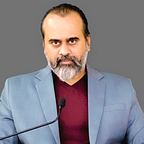Evolution and brain
The following is an excerpt from a samvaad (dialogue) session with Acharya Prashant.
Question: How did the brain evolve?
Acharya Prashant (AP): There is absolutely nothing. You could say, “Just material exists.” And then a few chemicals get together, a few chemicals get together, then few more chemicals, longer chains, longer polymers which are today called proteins. These proteins get together and they form a soupy, slippery substance called the protoplasm. What do they form?
Listeners (L): Protoplasm.
AP: Protoplasm. This protoplasm is still is inert, it has no consciousness. But given the way these chemicals, these molecules have come together, this protoplasm starts developing something which is not totally inert. It learns a way to respond to the environment. And slowly, gradually, your first single-cell organism is born. Relatives of that are today called by the name of amoeba, paramecium, and such names.
This amoeba too remains single-celled for a long period of time and then it learns to multiply. More complex organisms start coming into existence. And how does it learn to multiply? By again responding to the environment. By?
The amoeba knows nothing. All that it is doing is a response to its environment. It is absorbing everything from the environment. As a result of its…
